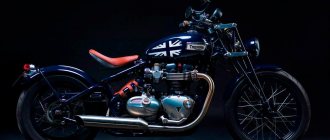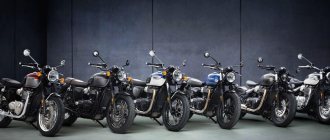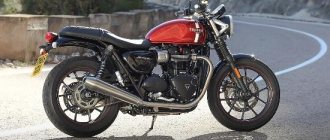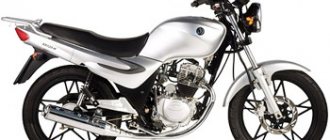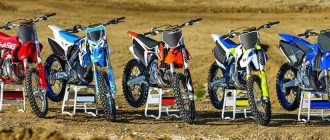Comparison of Indian Scout Bobber and Triumph Bonneville Bobber Black 2018
It’s funny to watch how oldfags fidget when they call these things bobbers, but sometimes circumstances force you to agree with them. This was the case when Indian and Triumph released these models. Many people take their first step into the motorcycle community from the gates of a custom workshop, so when a factory machine has to be called a bobber, some customizers feel sad.
Bobber
The term “bobber” originally means “shortened, trimmed,” therefore, when they say that a motorcycle has been “bobbed”, this means that it has been “sawed”, not very important and heavy parts have been cut off from the stock vehicle, for example, the front fender has been removed and installed it onto the rear wheel. However, these days the bobber is a lightweight cruiser with an aggressive look. The Triumph Bonneville Bobber Black and Indian Scout Bobber are low-slung egoists—niche machines that, in all fairness, should sell less well than their more versatile brethren. However, they sell like hotcakes. We are interested in finding out why, and at the same time finding out which of them is more worthy of spending (un)earned income on them.
These bobbers are a unique type of motorcycle for a unique type of rider. Both were designed to be stylish as stock and ready for further customization to communicate the owner's preferences. Both are slightly smaller than traditional full-size cruisers, but have serious engines that provide more than enough power to get you in and out of trouble. Both have a silhouette reminiscent of a traditional cruiser, while differing in important ways in terms of riding style—more for bar hopping than interstate. So which one is better? Depends on what you expect from it, but each has its own pleasant distinctive features.
Stylish as stock and ready for further customization
From an aesthetic point of view, the stock Triumph is more interesting. Its tubular frame with a pseudo-hardtail, a thin tank with a characteristic Triumph shape, imitation Amal carburetors and a solo spring seat make one think of the early period of bobber construction. They've really nailed the bobber chip, and Triumphs have often been the choice for bobbers, so the Bonneville is a suitable platform for a factory bobber. The Scout's powerful motor and frame strength panels are very good from a performance standpoint, but look unnecessarily bulky. But when it comes to customization, the Scout is the more obvious choice because it has a wider selection of parts and accessories. Triumph offers about 130 items in its catalog of accessories for Bobbers, but this number does not compare with the aftermarket for American V-twins.
Scout Bobber
It's hard to imagine a bike more suitable for building a peppy bobber than the Indian Scout. It already has a rigid frame, a powerful almost 100-horsepower engine and both wheels – 16” plump donuts. And from 2022 there won’t even be a need to build anything...
The Scout Bobber version was announced as a new product for 2022 and will be available at the factory in the fall of 2022. Let's see how the thoughts of the designers and constructors moved.
What made it impossible to call an ordinary “Scout” a bobber? Deep wings. Translated from English, Bobber is not a male beaver at all, but rather “cut like a beaver,” that is, devoid of decor. The wings should be trimmed as short and narrow as possible. This is what we did - no more than a quarter of the original size remained. The motorcycle immediately began to look lighter. After that, it was lowered at the rear using a barbaric method, removing a third of the already small 3” of rear wheel travel. There is only 2” of travel left - 50 mm, that is, it is not recommended to go on bad roads - it will shake you. They did not shorten the fork; they replaced its filling with more advanced cartridges, and installed a low handlebar on top, stylistically gravitating towards a drag bar. To avoid bending your back trying to reach it, the footpegs were moved a little back to the mid-control position. So instead of a hunchbacked back, we got a sporty stance with the torso tilted forward.
The amount of shiny chrome in the motorcycle was radically reduced in favor of blackening, so the motorcycle was visually made even more compact. Both 16” wheels in the base are on spoked wheels, not cast, and are shod with Taiwanese Kenda tires of moderate toothiness, the grip properties of which on wet asphalt I’m not sure about. And the choice of dual-purpose tires does not combine well with lowering the rear suspension. So the tires will most likely need to be changed.
Bright stylistic solutions with mirrors attached to the ends of the steering wheel (they can be installed both above and below the steering wheel) and a license plate mount on the side of the rear wheel will be standardly available for North America with its small license plate size. For our “snow shovels,” the mount will be in the center of the wheel, and the mirrors, also black and not chrome, will be mounted traditionally. In the photographs of the new product, I did not really understand what dictated the shape of the headlight housing, reminiscent of H.-D. Road King. Perhaps, to understand, you need to touch it with your hands or ride it, to evaluate its effect on aerodynamics. I don’t believe that the specialists of the large Polaris concern simply took it and copied it.
Otherwise, the motorcycle looks great both statically and in driving photographs, and I’m not worried about its fate - it will sell well.
OUTDOOR SPORTS > September 18, 2022 09:56 Denis DEAN Panferov
Controllability
When it comes to handling, neither of these bikes were built to perform wonders in corners, but that doesn't mean they don't handle. The low ride height of bobbers means there's a lot of kick in the footpegs when cornering, but the Bonneville Bobber frame has a couple of advantages. Its wheelbase is 150 centimeters, which is almost 7 centimeters shorter than the Scout, and the fork angle is sharper (25.4° for the Triumph and 29° for the Indian), which gives more responsive handling at low speeds and less resistance to leaning in turns. But the biggest difference in handling comes from the tires. Indian uses thick Kenda K761s with a "universal" tread pattern, which look great, but also greatly reduce handling. And Triumph's Avon Cobra tires provide excellent grip, a soft ride and more precise control.
Engine
Despite their different designs, the engines have similar characteristics and are equally fond of burnout. In theory, the Scout would pass the Bonneville, but the results on the dyno were different. Scout, according to the manufacturer, produces 100 hp. and 97.6 N_m, but the dyno showed 81.95 hp. and 85 N_m from the wheel. Triumph has a claimed power of 76bhp. and 105.8 N_m, but the real one turned out to be 73.3 hp. and 101.7 N_m, which is much closer to the declared characteristics. The ride feel matches these numbers exactly: the Triumph has more pull when releasing the clutch, but the Indian accelerates faster and pulls a little better at high revs.
Technical features
For several years, work has been going on to create a completely new generation of the Indian Scout Bobber motorcycle. Years of painstaking work were not in vain. This bike is capable of a lot. The V-Twin engine produces 100 horsepower.
The new engine is a true engineering work of art. Advantages: high power at idle and amazing elasticity. The V-shaped, 2-cylinder, liquid-cooled engine can become an assistant for a beginner, forgiving him inaccuracies. And also demonstrate character and dynamics, which will appeal to true connoisseurs and connoisseurs of motorcycle technology.
Nice details:
- chopped wings;
- Knobby tires;
- dynamic tire tread;
- license plate on the side;
- lowered rear suspension;
- targeted position of the pin;
- street tracker steering wheel for low profile.
The Indian Scout Bobber gives confidence in safety while driving due to the strongest traction torque in its class, which is available from the very bottom. The engine is mated to a 6-speed manual transmission with amazing feel and smooth shifting.
Specifications
| engine's type | V-twin liquid cooled, DOHC with 4 valves per cylinder |
| Engine displacement | 1133 cm3 |
| Power | 100 HP (75 kW) |
| Torque | 98 Nm |
| Fuel injection | Throttle valve 60 mm, lambda probe |
| Transmission type | Gear drive, wet clutch |
| Suspension: front - type/travel | Telescopic fork/120mm |
| Suspension: rear - type/travel | Dual shock absorbers/76mm |
| Brakes | Single / disc diameter 298 mm |
| Front wheel | 130/90-16 72N |
| Rear wheel | 150/80-16 71N |
| Length | 2311 mm |
| Width | 880 mm |
| Clearance | 135 mm |
| Seat height | 635 mm |
| Fuel tank volume | 12.5 l |
| Weight (dry/full tank) | 244 kg / 254 kg |
Brakes
The Bobber Black's dual Brembo front disc brakes are very responsive and perform well, but the front suspension is quite squishy under hard braking, even though it uses a Showa fork. One disc on the Scout Bobber was quite sufficient, and the suspension handles hard braking better. Ergonomically, both bikes are about the same with their low 'single' seats and low handlebars, but the Triumph's gear shifters and brakes deserve slightly higher marks. The Bonneville seat is adjustable and quite comfortable in the standard position, but it is firmer and gets uncomfortable a little quicker. Both bikes do not have passenger options.
Eventually
Conversion into a bobber quite expectedly reduces the comfort of long trips, but the strange combination of a thirsty engine and a 10-liter tank makes stops too frequent. Once fully refueled, the Scout can travel much further.
Both bikes have great engines, good chassis and decent suspension. The Triumph's ergonomics are preferable for short trips, but the firm seat makes me lean towards the Scout for rides longer than 20 minutes. The Bonnie looks significantly more stylish, but the Indian can be given a much more aftermarket makeover, and that balances the two out. The Bonneville Bobber has several modifications, and we tested the “charged” modification of the Bobber Black, but in the base it does not have cruise control, the suspension is a little simpler, and the front brake is single-disc, and the base model is closer in characteristics to the Scout. The advantages of a stock Scout are that it can go longer without stopping, its seat is more comfortable, and its tank capacity is larger.
The choice ultimately comes down to a balance of style and performance. For those wanting to ride a stock factory bobber, the Triump is the best choice. But when it comes to long trips or further customization, the Indian Scout Bobber is a better choice.
Appearance
The squat Indian Scout Bobber looks like a stalking animal and comes in a nice matte color scheme. The bike's design is highlighted by details that flow together seamlessly and effortlessly.
Black
Red
Silver
Matt black
Bronze
The Indian Scout Bobber, with its clear, precise lines, has always been distinguished by the absence of stereotypes. His appearance is memorable and catchy. The single leather seat is beautifully finished (with the possibility of installing a second seat and backrest).
An important external feature is the Indian Scout Bobber's stance (total 643 mm). But, at the same time, the landing is also a serious engineering decision - a low center of gravity and amazing weight balancing make the Indian Bobber easy to control.
Small elegant mirrors mounted on the “tracker” handlebar are also a distinctive feature of the motorcycle’s appearance. Coupled with a classic instrument panel with a minimalist set of functions, Indian Bobber recognition becomes 100 percent.
